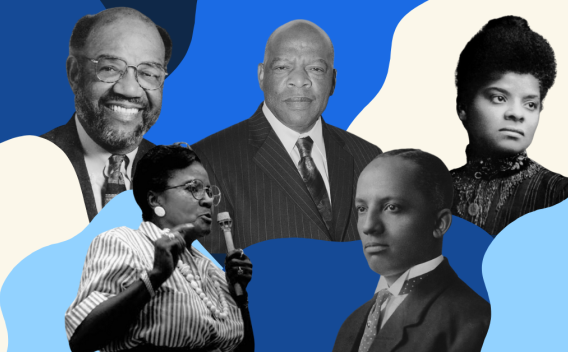By
Published
December 16, 2021
Tags
2021 has been an incredibly challenging year for women and girls, particularly for low-income women, women of color and trans and gender non-conforming people. The effects of the COVID-19 pandemic continue to disproportionately impact women and girls worldwide, and attacks on reproductive rights in the United States have intensified. It may feel as though these setbacks are impossible to reverse.
But there is hope. The past year has illuminated the areas that need urgent attention in the fight for women’s and girls’ rights. The organizations in our Gender and Reproductive Equity portfolio are leading efforts to build a safe, equitable world in which all people have bodily autonomy and freedom and where women hold greater economic and political power and leadership. They are working to ensure more women who are committed to gender and reproductive equity are able to hold political office and gain economic power, tackling harassment and violence in the workplace and at home, advocating for both paid and unpaid caregivers, and supporting efforts to ensure LGBTQ rights and reproductive justice.
It will take time, investment and creativity to advance gender and reproductive equity long-term, so sharing best practices is key. Throughout this year, our incredible partners have shared crucial insights from their work on the Schusterman blog. We hope you can draw inspiration for your own work from the four lessons we have learned from them this year so we can effectively support gender and reproductive equity in 2022.
1. Investing in women and girls to increase their political and economic power will benefit all of us.

(Photo: Ridofranz/iStock)
Let this sink in: while women and girls make up 50% of the world’s population, only 1.9% of all charitable dollars are donated to organizations focused on advancing the health, safety and rights of women and girls. Yet research spanning decades and countries proves that societies thrive when women and girls’ rights and voices are respected.
This is why, in 2021, Schusterman joined the Equality Can’t Wait Challenge, a partnership with Pivotal Ventures, Melinda French Gates’ investment and incubation company, and philanthropists MacKenzie Scott and Dan Jewett. Four awardees, led by indigenous women, Black women, and multiracial coalitions of women, were selected for grants of $10 million each to fund their critical work ensuring that all people can have access to truly equal opportunities and can realize their full potential. Read more from our Chair Stacy Schusterman about how these organizations plan to expand women’s power and influence by 2030.
Importantly, giving any amount can make a major difference. As our Co-President, Lisa Eisen, says, “every dollar towards women and girls is a step towards strengthening the economic and social fabric of our communities, and we each have the responsibility to give what we can.” Get started by checking out Lisa’s recommendations for finding great organizations to support.
2. Care work, whether paid or unpaid, is essential work, and we need to treat it as such.

(Photo: National Domestic Workers Alliance)
The pandemic has shown how essential the work of both paid and unpaid caregivers is to the functioning of our society. Unfortunately, governments and businesses have long undervalued and overlooked the needs of caregivers. Today, 20% of care workers live in poverty and 40% rely on public assistance.
Thankfully, advocacy organizations have been pushing for legislation that supports paid and unpaid care workers, such as expanding tax credits to organizations that provide emergency paid leave and sick days in the American Rescue Plan and increasing affordable childcare through the Build Back Better Act. But if we are to keep moving forward and build on the progress made, we must consider the historical context that led us to a care infrastructure that needs repair. Brook Kelly Green, our Senior Director of Gender and Reproductive Equity grantmaking, unpacks the history of care work and the initiatives leading the way in changing norms, increasing pay and securing rights for care workers.
One of these initiatives is the CARE Fund, a coalition that Schusterman joined earlier this year, which seeks to change policies and business practices to support caregivers and care workers. Already, the coalition has invested $2.5 million in essential nonprofits in the field to build a comprehensive care infrastructure that is long-term, intergenerational and inclusive. Our Co-President, Lisa Eisen, and Brook Kelly-Green share more about the impact of the CARE Fund here.
3. We need to change the policies and cultural attitudes that allowed domestic violence to increase during the COVID-19 pandemic.

Esta Soler with then-Vice President Joe Biden in 2015. President Biden has been a partner to Futures Without Violence for over two decades, helping to advance legislation to prevent and address gender-based violence. (Photo: Debbie Lee)
Before the pandemic, domestic violence was already widespread, with 1 in 4 women and 1 in 10 men in the U.S. reporting that they had experienced abuse from an intimate partner. Entrenched gender biases and economic stressors, which are known risk factors for this type of abuse, were already entrenched in many places worldwide even before the pandemic. Once lockdowns went into place and governments limited social interaction outside of people’s homes, domestic violence surged, with many calling it a “pandemic within a pandemic.”
That is why Futures Without Violence (FUTURES) has grown its domestic violence response efforts since the rise of COVID-19, training more than 25,000 professionals, including doctors, nurses, and childcare agencies, in how to respond to domestic violence. The organization also helped influence key federal legislation to provide much-needed aid to survivors, such as by helping to obtain $45 million in the CARES Act for shelters and other emergency needs.
While responding to the recent surge in domestic violence is critical, it is just as important to combat the structural inequities and cultural norms that allow domestic violence to fester. One of the ways FUTURES does this is through Coaching Boys Into Men, a program that supports athletic coaches talk to young male athletes about healthy and respectful relationships, dating violence, sexual assault and harassment. “Violence is learned. It’s supported by the culture. It’s patriarchy. It’s how women are treated. But if it’s learned, it can be unlearned,” shared Esta Soler, President and Founder of FUTURES. Learn more about this work in an interview with Esta and Sarah Gonzalez, FUTURES’ Program Director for Economic Justice and Workforce Initiatives.
4. Create a more just, healthy world by supporting the next generation of LGBTQ activists.

(Photo: Courtesy of Advocates for Youth)
2021 has been a particularly tough year for sexual health, reproductive freedom and LGBTQ rights, all central issues advancing gender equity. An unprecedented number of laws restricting access to abortion care has made 2021 the worst year for reproductive rights and abortion access in our country’s history. Several U.S. states have passed anti-queer or anti-trans legislation that codifies discrimination or removes protections for LGBTQ individuals.
For more than 40 years, Advocates for Youth has helped young activists lead the push for breakthroughs in reproductive and LGBTQ rights nationwide. Underpinning this work is the belief that LGBTQ equality, sexual health and reproductive rights is a long game. As Louie Ortez-Fonseca, Advocates for Youth’s Director of LGBTQ Health and Rights, stated in an interview for our blog earlier this year, “things are hard, and they are going to get harder.”
However, what gives Louie hope is the resilience of the young activists he works with—and everything they have to teach adult allies. The core of this work is deep, ongoing partnerships with young people, particularly Black, brown, indigenous, queer, and trans individuals. Hear more from Louie about how youth allyship and collaboration is crucial to securing gender equity long-term.
Want to learn about the latest efforts to advance gender equity in 2022? Check out our Gender and Reproductive Equity portfolio and get to know our partners leading this work.





